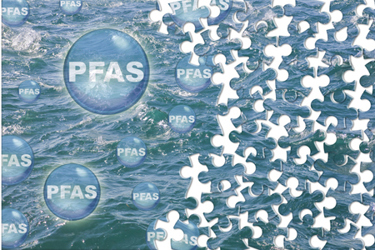Beyond Water: Managing PFAS For The Long-Term
By Dr. Dora Chiang and Dr. Russell Ford

Per- and polyfluoroalkyl substances (PFAS) continue to demand the attention of communities, businesses, and policymakers around the world. In the last few weeks alone, studies have found: that PFAS absorb through the skin at much faster levels than previously thought; that certain foods are linked to higher PFAS levels in humans; that there are high levels of PFAS near manufacturing plants of lithium ion batteries and; that landfills in the U.S. are leaching PFAS gasses into the atmosphere.
Today, efforts at reducing PFAS are largely focused on the treatment of drinking water. To rise to the challenge, we need comprehensive strategies that also address the sources of PFAS. We need to tackle the lifecycle of PFAS. This includes transforming supply chains to reduce the use of PFAS in manufacturing, supporting the circular economy by segregating wastes to increase recycling, and minimizing PFAS-containing wastes for off-facility disposal and destruction.
Starting At The Source
To effectively manage PFAS in the long term, we need to identify and address them at source. PFAS have been widely used in a range of processes and goods for decades, resulting in comingled PFAS footprints that make understanding the PFAS behavior at each site complex. The U.S. EPA estimates that there are more than 120,000 PFAS sites in the United States — each with its own set of complexities and characteristics.
Now, a process known as “fingerprinting” is enabling communities and businesses to identify PFAS sources. Like human fingerprinting, this technology allows identification of specific PFAS compounds among the thousands that exist. Jacobs’ PFAS data evaluation toolset uses a proprietary process that maps the transformation pathways of hundreds of PFAS compounds to identify sources and release history. Data is visualized in dashboards to inform decision-making and support stakeholder engagement.
PFAS Source Identification Supports More Effective Remediation And Treatment Solutions
Around the world, communities are already proving that by identifying and remediating the sources of PFAS it is possible to reduce, or avoid altogether, ongoing, costly PFAS treatment.
For example, the City of North Bay in Ontario, Canada, is remediating PFAS contamination at Jack Garland Airport by addressing both on-airport source zones of PFAS to drinking water and evaluating treatment for the drinking water. This approach considers both sides of the equation to solve the challenge holistically.
Elsewhere, the use of digital identification tools and a sewer system sampling plan by a municipality in the northeast U.S. will allow the local community to identify where PFAS are entering its systems — e.g., industry and landfill — and can then collaborate with stakeholders to remove much of them at the source.
In the UK, the Environment Agency has deployed innovative geographic information system (GIS) tools to identify PFAS risks to the water environment in England. This PFAS Risk Explorer powers a portal that the agency can use to present and analyze the results of national water sampling.
Moving From Reactive To Proactive
With more regulations established globally, downstream treatment of all impacted on-site and off-site media can be impractical. A sustainable PFAS strategy requires parallel actions from the reactive approach of reducing contamination in the environment to embrace a proactive paradigm focused on source reduction across the entire PFAS lifecycle, including industry partnerships and community engagement.
There are significant challenges to be addressed, including mitigating environmental liabilities, increasing recyclable PFAS wastes, and reducing the use of PFAS in products. PFAS supply chain management techniques now need to be part of every organization’s ESG and circular economy objectives. In turn, this will help drive research and development for product replacement alongside environmental protection goals.
Moving Beyond Water For Sustainable PFAS Management
PFAS are ubiquitous and persistent, designed to be water repellant and heat resistant — the very properties that make them useful — but also make them hard to destroy.
Removing PFAS from drinking water is a sensible first step, but the safe and sustainable management of PFAS in the long-term requires us to do so much more. By working across sectors, with both communities and industry, identifying PFAS sources and employing near-zero cleanup methods, removing them wherever possible from manufacturing processes, all while continuing to treat downstream pollution, we can get there.

Dr. Dora Chiang is the Global Principal for PFAS & Emerging Contaminants at Jacobs.

Dr. Russell Ford is the Global Director for Drinking Water and Reuse Solutions at Jacobs.
